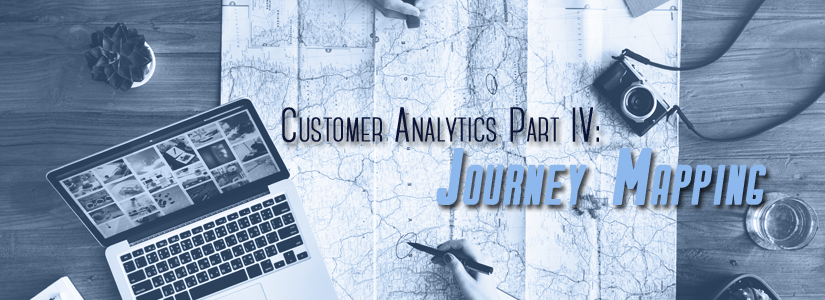
Customer Analytics Part IV: Journey Mapping
Now that you’ve learned where to look for customer data, thought about how to put that data in context, and ensured that your data is set up for comparison and visualization, let’s explore an actionable analysis of all that data—the customer journey map.
What is a Customer Journey Map?
A customer journey map plots the steps and touchpoints that lead a customer to using your product or service. It’s a visualization that shows the flow from the customer finding your product through the steps the customer takes to learn more, to purchase or to abandon their interaction.
The goal of a journey map is to unmask the hidden stumbling blocks that prevent an interested consumer from converting into a customer and to see what parts of their interaction run most smoothly. Looking at your company from the perspective of your customer gives you a larger picture of how your various departments are interacting and supporting your company’s goals.
Framing the Journey: How to Set Up Your Customer Journey Map
1. Do you want to explore the whole journey or narrow your focus on a specific channel? You first need to determine if you are trying to get a broad picture, or if you want to understand, for example, how well your website is working.
⋅ Broad journey analysis—The big picture view of all of your customer touchpoints will start before the customer has ever interacted with you and will continue after she uses your product to consider referrals and repeat purchasing. This is a complex analysis with a large number of touchpoints, but it gives you the opportunity to understand how each part of your company is working toward your goals.
⋅ Specific journey—Narrowing your focus will let you dive more deeply into understanding your main channels of interaction, such as your website. In this case, you will gather detailed data on how a customer navigates the particular channel, when he needs to switch channels, or if the channel is often abandoned.
2. How will you focus on a customer’s perspective? You next need to decide from which customer’s point of view you will map a customer journey. Then, build a persona that allows you to explore—maybe it is based on your highest value customers or you might focus on first time conversions.
3. What information about the customer will you track?
⋅ Motivations—What is the customer looking for at a particular time in their journey? What are their goals? You want to make sure your company is engaging and giving a customer the tools she needs to meet her goal at each touchpoint.
⋅ Experience—What are the options for the customer at each touchpoint? Consider the tools you provide to a customer, and also any external options available, such as Google or competitor websites.
⋅ Itemize the links you have provided in emails, the search options on your website, the customer support options on- and offline; map out exactly what is available to your customer at each stage of interaction.
⋅ Customer thoughts and feelings—How happy is the customer with what your company has provided at each stage of her interaction?
Think about a customers’ general feelings: e.g. will they be feeling overwhelmed because they researching a complicated product? Then use your data to figure out how they feel about the service they are receiving from your company at each particular touchpoint: e.g., are you helping to alleviate the stress that makes their research overwhelming?
4. Bring in the data—Once you’ve set up your framework and mapped the company’s services at each touchpoint (email ads and links, website tools, customer service on- and offline), look to your analytics.
Look at engagement rates and abandonment rates, and qualitative feedback including customer inquiries and survey responses, at each of the stages you identified to uncover those hidden problem areas that prevent customer satisfaction.
Journey mapping is not a simple analysis; but it is one of the best ways to combine knowledge from all of your customer data. Take a look at some example journey maps and begin planning to capture the right data to complete the picture of your customer’s journey.

